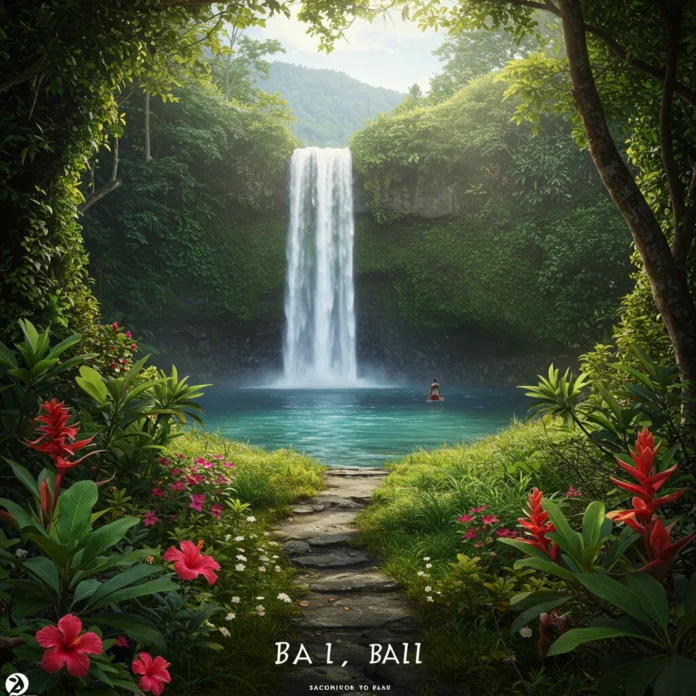Introduction: Why Bali’s Waterfalls Are the Island’s Best-Kept Secrets
Bali is celebrated worldwide for its lush rice terraces, vibrant temples, and golden beaches, but few realize that some of its most breathtaking wonders lie hidden within its verdant jungles. The island’s waterfalls remain largely untouched by mass tourism, offering tranquility and raw natural beauty that often escape the typical traveler’s itinerary.
We often hear about Bali’s surf and nightlife, but have you ever paused to consider the soothing sound of cascading water echoing through misty valleys? These secluded sites provide a rare opportunity to connect with nature and experience the island’s authentic heart.
What Makes Bali’s Hidden Waterfalls Unique?
Bali’s lesser-known waterfalls stand apart due to their unspoiled surroundings and the sense of discovery that accompanies each visit. Unlike their more popular counterparts, these gems are tucked away from busy roads and commercial development, preserving their pristine charm.
Every waterfall possesses its own character—some are framed by towering cliffs, others filtered through jungle canopies, and a few reveal themselves only after a rewarding trek. This variety ensures that each site offers a distinct sensory experience, from the cool spray on your face to the earthy scent of moss-covered stones.
How to Find Bali’s Hidden Waterfalls
Locating Bali’s secret waterfalls requires a spirit of adventure and a willingness to venture off the beaten path. Most are found in the island’s interior, far from the bustling southern coast.
We recommend using reliable GPS navigation, consulting local guides, or booking activities through trusted platforms. Many travelers find that organized tours simplify logistics and enhance safety, especially when tackling remote or challenging trails.
When Is the Best Time to Visit Waterfalls in Bali?
Timing can dramatically influence your waterfall experience. Bali’s tropical climate features distinct wet and dry seasons, each affecting accessibility and water flow.
The dry season (April to October) typically offers easier hiking conditions and clearer water, while the wet season (November to March) brings more dramatic cascades but can make trails slippery and river crossings riskier. Early mornings often provide the softest light and fewer crowds, regardless of the season.
Essential Tips for Exploring Bali’s Waterfalls Safely
Prioritizing safety ensures that your adventure remains enjoyable. Many waterfalls require hiking through dense jungle, crossing streams, or descending steep steps.
- Wear sturdy, non-slip footwear for uneven terrain.
- Check weather forecasts to avoid heavy rainfall and flash floods.
- Inform someone of your plans, especially if venturing independently.
- Bring enough water and a fully charged phone.
What to Pack for a Bali Waterfall Adventure
Preparation makes all the difference when visiting remote natural sites. We suggest packing light but thoughtfully for comfort and safety.
- Quick-drying clothes and a change of attire
- Waterproof bags for electronics
- Reusable water bottle
- Insect repellent and sunscreen
- Snacks or energy bars
Respecting Local Culture and Nature at Waterfall Sites
Bali’s waterfalls often hold spiritual significance for local communities. Visitors are expected to show respect, both for nature and cultural practices.
Avoid loud behavior, do not litter, and follow posted guidelines. Modest dress is appreciated, especially near temple sites or when locals are present.
The Top 3 Breathtaking Hidden Waterfalls in Bali
Let us introduce three of Bali’s most awe-inspiring, lesser-known waterfalls. Each promises a unique blend of scenery, adventure, and tranquility, making them must-see destinations for nature enthusiasts.
1. Sekumpul Waterfall: Bali’s Most Majestic Cascade
Sekumpul Waterfall is often regarded as the crown jewel among Bali’s hidden cascades. Its multi-tiered streams thunder down lush cliffs, creating a mesmerizing spectacle that draws those seeking grandeur and serenity alike.
Where Is Sekumpul Waterfall Located?
Sekumpul Waterfall is situated in the northern region of Bali, within the Singaraja district. The area is characterized by dense rainforest and rural villages, offering a peaceful escape from the island’s busier regions.
How to Get to Sekumpul Waterfall
Reaching Sekumpul requires a drive of approximately two hours from Ubud or three hours from southern Bali. The final approach involves a moderate trek through plantations and down a series of steps. Many visitors opt to book activities with local guides for added safety and insight.
What to Expect at Sekumpul Waterfall
Prepare to be greeted by multiple streams plunging over 80 meters into a lush valley. The air is cool and filled with mist, and the thunderous roar of water creates a dramatic backdrop. The area is shaded by dense foliage, with natural pools at the base for relaxation.
Best Time to Visit Sekumpul Waterfall
The dry season is ideal for visiting, as trails are less slippery and water clarity is at its best. Early mornings offer softer light and fewer visitors, enhancing the sense of solitude.
Can You Swim at Sekumpul Waterfall?
Swimming is permitted in the lower pools, but caution is advised due to strong currents and slippery rocks. We recommend observing local safety signs and never swimming alone.
Photography Tips for Sekumpul Waterfall
For the best photos, use a wide-angle lens to capture the full scale of the falls. Early morning or late afternoon light adds warmth and reduces harsh shadows. Waterproof cases protect your equipment from mist and spray.
Nearby Attractions Around Sekumpul Waterfall
Several other waterfalls, such as Fiji and Lemukih, are within trekking distance. Local villages offer authentic Balinese cuisine and opportunities to observe traditional crafts.
2. Tukad Cepung Waterfall: The Hidden Cave Gem
Tukad Cepung Waterfall is celebrated for its unique setting, where sunlight streams through a narrow cave, illuminating the falling water in a magical display. This site appeals to those seeking a truly otherworldly experience.
Where Is Tukad Cepung Waterfall Located?
Tukad Cepung is located near Bangli, central Bali, about an hour’s drive from Ubud. The waterfall sits within a narrow canyon, surrounded by lush jungle.
How to Reach Tukad Cepung Waterfall
After parking, visitors descend a series of steps and wade through a shallow stream to reach the cave entrance. The journey is short but requires careful footing, especially during the rainy season.
What Makes Tukad Cepung Waterfall Special?
The interplay of light and water at Tukad Cepung creates a surreal atmosphere, with sunbeams piercing the cave and illuminating the mist. This spectacle is a favorite among photographers and those seeking a sense of wonder.
As experts often say:
“The beauty of a place is not just in what you see, but in how it makes you feel. Bali’s waterfalls remind us to pause and appreciate the world’s quiet marvels.”
Best Time to Visit Tukad Cepung Waterfall
Visit between 9 and 11 a.m. when sunlight enters the cave at the perfect angle, creating dramatic rays. Weekdays are quieter, allowing for a more intimate experience.
Is Swimming Allowed at Tukad Cepung Waterfall?
While swimming is possible in the shallow pool, the main attraction is the visual spectacle. The water is cool and refreshing, but the rocky surroundings require caution.
Tips for Photographing Tukad Cepung’s Light Rays
Arrive early and use a tripod to capture the ethereal light. Slow shutter speeds enhance the effect of the falling water, while adjusting your position helps frame the sunbeams perfectly.
Nearby Cafés and Facilities at Tukad Cepung
Several small cafés and warungs near the entrance offer refreshments and local snacks. Basic facilities, including restrooms and parking, are available for visitors’ convenience.
3. Nungnung Waterfall: The Towering Powerhouse
Nungnung Waterfall is renowned for its sheer height and powerful flow, making it one of Bali’s most impressive natural spectacles. The journey to its base rewards visitors with a dramatic encounter with nature’s force.
Where Is Nungnung Waterfall Located?
Nungnung is found in Bali’s central highlands, approximately 35 kilometers north of Ubud. The area is surrounded by rice fields and rural landscapes, providing a scenic drive en route.
How to Access Nungnung Waterfall
Visitors must descend over 500 well-maintained steps through dense jungle to reach the base. The return climb can be strenuous, so pacing and hydration are important.
What Awaits You at Nungnung Waterfall?
A towering cascade plunges nearly 50 meters into a wide pool, sending up a fine mist that cools the air. The sound is invigorating, and the lush greenery creates a dramatic setting for relaxation and contemplation.
Best Time to Experience Nungnung Waterfall
The waterfall is most accessible during the dry season, when the steps are less slippery and the water is clear. Early visits avoid midday heat and larger crowds.
Is Nungnung Waterfall Suitable for Families?
Nungnung can be visited by families with older children comfortable with stairs and moderate physical exertion. The site is not recommended for very young children or those with mobility concerns.
Safety Tips for Visiting Nungnung Waterfall
Wear sturdy shoes, take breaks on the ascent, and be cautious near the water’s edge, as rocks can be slippery. Always supervise children and avoid visiting during heavy rain.
Nearby Attractions and Villages Near Nungnung
The surrounding region features picturesque villages and rice terraces. Local warungs offer traditional Balinese dishes, providing a perfect end to your adventure.
Comparing Bali’s Hidden Waterfalls: Which One Is Right for You?
Choosing between Sekumpul, Tukad Cepung, and Nungnung depends on your interests and fitness level. Sekumpul impresses with its grandeur, Tukad Cepung captivates with its mystical light, and Nungnung challenges with its power and rewarding trek.
- For photographers: Tukad Cepung’s light rays are unparalleled.
- For adventure seekers: Nungnung offers a challenging hike and powerful scenery.
- For those seeking variety: Sekumpul’s multi-tiered falls and nearby attractions deliver a comprehensive experience.
Map of Bali’s Hidden Waterfalls: Plan Your Route
Planning your journey efficiently saves time and energy. Online mapping tools and local tourism offices provide updated information on routes and road conditions. We suggest grouping waterfalls within the same region to maximize your experience.
How to Combine Waterfall Visits with Other Bali Adventures
Bali’s interior offers more than waterfalls. Many travelers combine visits with trekking, cycling, or exploring nearby temples and villages. This approach enriches your understanding of the island’s culture and natural diversity.
What Are the Best Guided Waterfall Tours in Bali?
Guided tours offer convenience, local insight, and added safety. Reputable providers often include transportation, entrance fees, and knowledgeable guides who share stories and cultural context. You can find tours tailored to different interests and fitness levels.
Can You Visit Bali’s Waterfalls Independently?
Independent visits are possible for those comfortable navigating rural roads and hiking trails. Researching routes, checking recent reviews, and preparing adequately are essential. Solo travelers should inform others of their plans and carry emergency contacts.
Are Bali’s Hidden Waterfalls Family Friendly?
Many waterfalls are suitable for families with older children, especially those comfortable with moderate hikes. Some sites, such as Tukad Cepung, require wading and careful supervision. Always assess the physical demands before setting out with young travelers.
How Accessible Are Bali’s Waterfalls for Different Fitness Levels?
Accessibility varies widely. While some waterfalls require strenuous hikes or steep descents, others offer easier paths and shorter walks. We recommend reviewing trail descriptions and consulting guides to select sites that match your abilities.
Sustainable Tourism: Protecting Bali’s Waterfalls for Future Generations
Responsible travel practices help preserve Bali’s natural beauty. Visitors can minimize their impact by staying on marked trails, avoiding single-use plastics, and respecting wildlife. Supporting local communities through ethical tourism ensures that these sites remain protected and cherished.
What Are the Entrance Fees and Regulations at Waterfall Sites?
Most waterfalls charge a modest entrance fee, which supports local maintenance and conservation. Regulations may include restrictions on swimming, drone usage, or waste disposal. Always check posted signs and follow the guidance of local staff.
What Should You Wear When Visiting Waterfalls in Bali?
Comfortable, moisture-wicking clothing is ideal. Water shoes or sturdy sandals provide grip on wet surfaces. Modest attire is appreciated in culturally sensitive areas, and a hat or light jacket may be useful during cooler mornings.
What Are the Best Local Foods to Try Near the Waterfalls?
Local warungs near waterfall sites serve traditional Balinese dishes such as nasi campur, sate lilit, and fresh coconut water. Sampling these meals supports local economies and adds a delicious dimension to your adventure.
Hidden Waterfall Etiquette: Do’s and Don’ts
- Do respect posted rules and local customs.
- Do pack out all trash and leave the site cleaner than you found it.
- Don’t disturb wildlife or pick plants.
- Don’t play loud music or disrupt the peaceful atmosphere.
How to Capture the Perfect Waterfall Photo in Bali
Lighting, composition, and timing are key to memorable waterfall photos. Early morning or late afternoon provides soft, diffused light. Use a tripod for long exposures to create silky water effects. Experiment with angles to highlight the waterfall’s unique features.
Packing Checklist: Must-Have Gear for Waterfall Explorers
- Waterproof bag or dry sack
- Sturdy footwear
- Quick-drying towel
- Reusable water bottle
- First-aid kit
- Camera or smartphone with protective case
How to Stay Safe from Leeches, Insects, and Wildlife
Applying insect repellent and wearing long sleeves can help prevent bites. Stay on marked trails to avoid encounters with wildlife. If you spot leeches, remove them promptly with salt or a tissue, and clean the area to prevent infection.
Are There Lesser-Known Waterfalls Worth Visiting in Bali?
Bali is home to dozens of lesser-known waterfalls, such as Banyumala Twin Waterfall and Blemantung, each offering unique scenery and solitude. Exploring these sites rewards those seeking a deeper connection with the island’s natural wonders.
How to Respect Local Spiritual Beliefs at Waterfall Sites
Many waterfalls are considered sacred. Avoid public displays of affection, dress modestly, and never enter areas marked as off-limits. Observing rituals or offerings with quiet respect honors local traditions.
What to Do If You Get Lost or Need Help at a Waterfall
If you lose your way, remain calm and retrace your steps if possible. Carrying a fully charged phone and a local SIM card enables you to call for assistance. Local guides and villagers are often willing to help lost visitors.
How to Book on Viator
For those seeking a seamless and secure booking experience, we recommend arranging your Bali waterfall adventures through Viator. They offer a wide selection of guided tours, private excursions, and activity packages tailored to various interests and fitness levels. To book activities or find tours, simply visit their website and explore the latest offerings for Bali’s hidden waterfalls.
Conclusion: Why Bali’s Hidden Waterfalls Should Be on Your Bucket List
Bali’s hidden waterfalls offer more than just scenic beauty—they provide moments of peace, adventure, and cultural insight that linger long after your visit. By venturing beyond the usual attractions, we gain a deeper appreciation for the island’s natural and spiritual heritage.
At Izase, we believe that meaningful travel is about seeking out authentic experiences and respecting the places we visit. For more inspiration and practical tips, visit our website and start planning your next unforgettable journey.
Disclaimer: This information is accurate to the best of our knowledge; however, there may be changes or mistakes. Please verify exact details on the Viator booking page.




